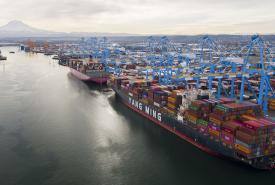The Port of Hamburg will begin using feeder ships to transfer containers between its terminals next month.
From 1 November, feeder ships will be used to relieve road networks between terminals, with the aim to reduce terminal waiting time and decrease CO2 emissions.
The collaboration is launched through Danish shipping company Unifeeder as initiator, together with the Hamburg software specialist DAKOSY and DIHLA DAKOSY Interessengemeinschaft Hamburger Linienagenten (DIHLA).
Containers will be moved by feeder ship between the HHLA terminals CTA, CTT and CTB, as well as Eurogate and, in the near future, the Süd-West Terminal.
READ: Halifax & Hamburg sign deal to decarbonise shipping corridor
In the future, Unifeeder is endeavouring to switch 50 per cent of its transshipment operations from trucks to feeder carriers.
At the port, transshipments – transfers of containers between large container ships and feeder vessels – which are not loaded at the same terminal happen on a huge scale.
In total, the Port of Hamburg had approximately 3.3 million TEU of transshipments in 2021, although not every transfer results in a transshipment.
“Ship-based transshipments can take several thousand containers off the road each year. Every container we can move via waterway means a reduction in CO2,” DIHLA Managing Director Alexander Geisler said.
The parties have collectively created a digital process that covers customs handling.
DAKOSY, DIHLA and Unifeeder jointly established the framework for the digital processes and customs handling of feeder transhipments.
The basis is the Port Community System operated by DAKOSY, featuring the integration of a new module. The module has already proven itself in live testing: during the three-month pilot phase, Unifeeder transferred about 50 containers per month.
DIHLA has covered the initial financing for the digital processes required to implement feeder transhipments.









